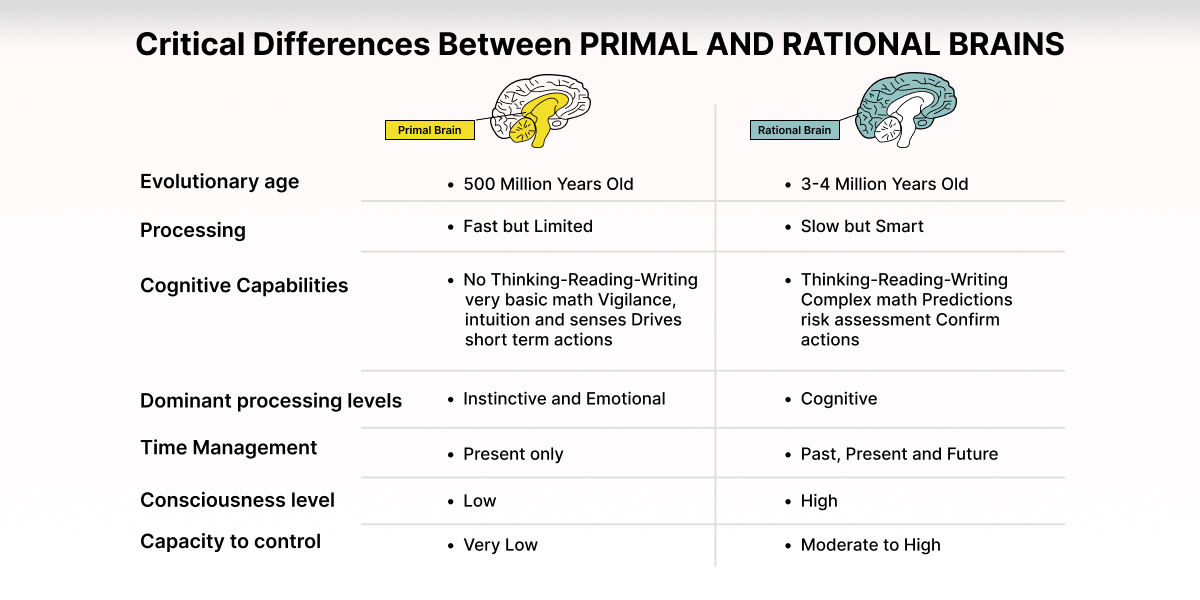Greetings, dear CEOs of today and unicorns of tomorrow! Can you fathom how billions vanish into ad campaigns that can’t even get us to bat an eye? It’s like humanity’s been playing persuasion games since forever, trying to bend each other’s wills.
Lend me your ears, frontal lobes, amygdalas, and hippocampi. Why, you ask? We’re not launching a brain-collection campaign (relax, Frankenstein). We’re indeed about to dive headfirst into the world of Neuromarketing: the kingdom where science and shopping carts collide 😊
Neuroscience x marketing = Win lane for your business
Neuromarketing is just like Professor X of your business world, helping you to read the mind of your customers, unraveling why they prefer polka dots over stripes and why a catchy jingle makes consumer tap their credit cards faster than a cat chasing a laser pointer.
So dear readers, prepare to be enlightened, and dare we say it-electrified! After all, who knew understanding brain waves could be as much fun as surfing ocean waves? So, put your thinking caps on and read a guide on neuromarketing, the secret weapon making your consumers tick, click and stick!
What is Neuromarketing?
It is the scientific study of how the brain reacts to branding and advertising.
Neuromarketing utilizes insights from
- Neuroscience
- Behavioral economics
- Social psychology
The goal of neuromarketing is to measure and improve the effectiveness facet of marketing, including
- Product design
- Branding
- Marketing practices
Ever wondered what are the underlying reasons behind people’s behavior? What motivates them to click and purchase things? Neuroscience has the answers!
Thanks to the remarkable growth of neuroscience over the last 20 years. Our post is grounded in the extensive research of renowned decision scientists, psychologists, and behavioral economists. Figures like Richard Thaler, Dr. Robert Cialdini, Dan Ariely, Daniel Kahneman, and numerous others have shaped our understanding of human behavior and the factors influencing decision-making.
How Are Decisions Made in The Brain?
You probably heard about the right and left brain. In addition to this, the brain is organized into two critical systems with different structures and functions: The Primal and the Rational brain.
Primal Brain: The oldest system ensuring safety, attention, emotions, and managing internal states for survival. It dominates processing persuasive messages.
Rational Brain: The evolved part of the brain, like an adaptable operating system. The rational brain utilizes higher cognitive resources to mediate primal responses.

Once you grasp the distinction, you unlock the key determinant: The Primal Brain,” the true driver behind decision-making. Once you learn more about this, your marketing and sales strategy can apply different communication principles effectively.
Speak to the Primal Brain: Transform your Advertisement
If you are reading this, you are about to learn how to harness the hidden potential of the primal brain to supercharge your advertisement. To truly understand the primal brain’s potential and get the desired results from your ads, it’s essential to explore how persuasion is a bottom-up process for your business. And how do you do that? Here are fundamental persuasion biases that instantly trigger the Primal brain response.
The Magnetic pull of Emotions
Feel the pulse of Primal Brain as it intertwines with emotions, igniting symphonies of chemicals within. This primal epicenter booms on emotional explosions. Without an intense emotional cocktail, events fade into oblivion. No feelings, no decisions. To draw the audience into your influence, you need to identify the emotional triggers that resonate with your audience.
For Example consider the ad of coca cola how it leaves a lasting imprint by resonating with the Primal Brain. The advertisement often features people connecting, sharing special moments, evoking joy, togetherness, and celebration.
Don’t Just Tell: Inspire with Visuals
Visuals are the primal brain’s superhighway. The connection of the optical nerve (the nerves that carry visual signals from the eye to the brain) with the primal brain is incredibly swift, at least 25 times faster than the auditory nerves (the nerves that carry the information from the inner ear to the brain). As a result, visuals dominate the primal brain’s sensory perception, making them vital to your advertising.
For Example learn from Nike’s advertisement. Nike is a brand that effectively utilizes visuals to engage the primal brain. Nike’s advertisement features captivating visuals of athletes pushing their limits, showcasing their determination, and celebrating their triumphs.
Personalize Your Message; Make Your Audience the Hero
Your primal brain is the epicenter of the self. This powerful core has no time for anything that doesn’t scream “Me, Me, Me.” Its top priority? Self-preservation, baby! It is always on high alert for threats. It responds to danger like a superhero on a mission.
For Example, think of Apple’s Siri. It is designed to cater to the “me” center of our brain. Like the primal brain, Siri only focuses on things that directly benefit you. It addresses the immediate needs and queries, adapting your habits and preferences. Remember how vigilantly it listens for the ‘Hey Siri’ command, ready to respond immediately!
Make Your Story Memorable
Memory is the primal brain’s arch-nemesis. It remembers little! So, if you want your message to stick, you better start strong and end strong. Make it like a catchy song with a killer chorus that keeps playing in the heads. And what about the middle? Keep it short and sweet. Just a few convincing arguments will do the trick. Brevity is the secret sauce to a primal-friendly delivery. And don’t forget the power of storytelling! Craft a narrative that’s easy to remember.
For Example, you must have seen the McDonald’s engaging advertisement. They begin dynamically, with a mouth-watering visual of your favorite food items, and conclude with the famous Golden Arches logo and “I’m Lovin’ it” tagline. Sandwiched between these, there’s a brief, persuasive narrative about the joy of enjoying a McDonald’s meal.
Tangible Input
It would be best to speak Primal brain’s language to get through it genuinely. And what’s that, do you want to know? Tangible input! This brain craves familiarity and friendliness. It wants things that recognize quickly, like a comfy old pair of socks or a reliable pizza joint. Complexity? Forget about it! It wants simplicity, easy-to-grasp ideas that don’t require Olympic-level mental gymnastics routines. Complicated, ambiguous instruction would only lead to confusion and skepticism.
Example: Lego sets an excellent standard to make your proofs tangible. Each set has a clear, easy-to-follow guide using simple visuals and step-by-step instructions. It embodies the simplicity and concrete nature that the primal brain craves.
Contrastable Arguments
The primal brain thrives on solid comparisons like before and after, risky versus safe, with or without, and slow or fast. These stark differences allow it to make lightning-fast, risk-free decisions. Without contrast, our little brain plunges into a state of confusion, and confusion is the nemesis of decision-making. It’s like being stuck in a never-ending loop of “Uhh… what now?”
Example: Reflect on Amazon’s “From A to Z” promise. This tagline illustrates a before and after contrast. Back, you searched for your needs in multiple places, but after, you found everything in one place. It underscores the difference between complication/simplicity, communicating the idea that even shopping in various places feels safe; it’s simpler and more efficient to shop at Amazon.
Empower Your Persuasive Abilities with These Three Steps
Mastering the dominant stimulus for the primal brain is an outstanding achievement. Still, before you unleash your message, it’s time to tackle the three critical questions that will make your audience say, Wow, now that’s a message I can’t ignore. The three questions are
- What’s in it for me?
- Why should I care?
- How is this different?
Target the Pain Points: Understand What Drives Decisions
Diagnosing PAINS: By identifying the most critical decision drivers that impact customer behavior, you gain insights into what motivates your audience.
Awakening Fears: Our primal nature directs attention to messages that evoke fear.
Articulating Pain Elimination: Communicating how a product or solution addresses specific PAINS.
Consideration and Urgency: Products or solutions that effectively address PAINS receive increased consideration and create a sense of urgency.
Create Persuasive Claims: Make Your Value Stand Out
Simplify messaging: Condense key points into easy-to-pronounce words.
Organize with clarity: Present claims under three clear points or arguments.
Choose readable messages: Use fluent fonts for easy processing by the Primal brain.
Prioritize simplicity: Keep communication clear and free of complexity.
Provide Convincing Evidence: Demonstrate Tangible Benefits
Simplify value demonstration: Make your message easy to understand in the present moment, even for non-experts.
Customer testimonials and demos: Use real customer stories and interactive demonstrations to create impactful "ah-ha" moments that confirm the decision for your target audience.
Focus on present decision-making: Highlight immediate benefits and practical applications to effectively address current needs and pain points.
Neuromarketing Toolbox
We have explored the captivating world of persuasive stimulus and the power of questions. Next, it’s time to apply neuromarketing and gain valuable insights effectively. For this purpose, selecting the right tools and methods is crucial. Here we suggest a few neuromarketing tools to tap into the subconscious level and enable effective neuromarketing strategies.
EEG (Electroencephalography)
- Measures brain waves and translates them into reliable metrics and emotions.
- Provides real-time tracking of cognitive processes and emotional engagement.
- Offers millisecond-level precision for capturing brain activity.
IAT (Implicit Association Test)
- Measures the strength of associations between two concepts based on reaction speed.
- Reveals subconscious biases and implicit attitudes.
- Uncovers hidden preferences and provides insights into consumer behavior.
Eye Tracking
- Tracks eye movements to determine areas of focus and attention.
- Helps optimize design and content placement for maximum impact.
- Provides valuable insights into visual attention patterns.
Biometrics
- Monitors physiological responses such as heart rate and skin conductance.
- Offers insights into emotional arousal and engagement.
- Provides objective measures of consumers' physiological reactions to marketing stimuli.
Emotion Recognition
- Analyzes facial expressions to identify and measure emotional responses.
- Helps understand the emotional impact of advertisements.
- Enables marketers to tailor content based on emotional cues.
Boost your business with neuromarketing.
Don’t leave your marketing success up to luck. With the proper guidance and our practical insights, as shared above, you can achieve remarkable outcomes. And as we have navigated the primal brain and decoded biases, you might wonder,” Who will build me a software solution that effectively delivers these compelling messages?
Your search ends here and now! We are a software development agency that effortlessly marries the world of coding with the science of neuromarketing. Aspired balances codes and neurons like a tightrope walker on espresso.
Let’s code an app that sticks and strikes a primal chord. Let’s do it all with Aspired!

 Clients
Clients
 Processes
Processes
 Blog
Blog










